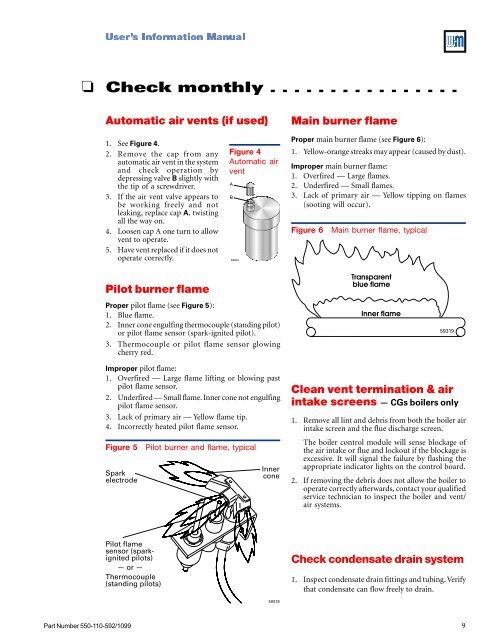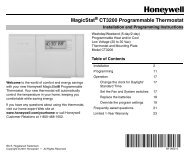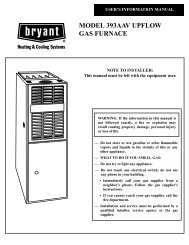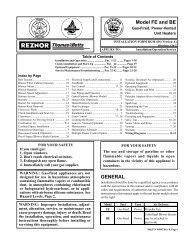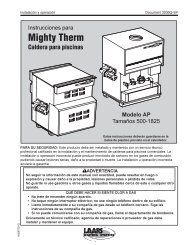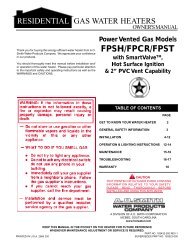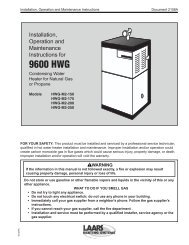CGa, CGi, CGs, EG, EGH, LGB, PEG, PFG - Geisel
CGa, CGi, CGs, EG, EGH, LGB, PEG, PFG - Geisel
CGa, CGi, CGs, EG, EGH, LGB, PEG, PFG - Geisel
You also want an ePaper? Increase the reach of your titles
YUMPU automatically turns print PDFs into web optimized ePapers that Google loves.
Part Number 550-110-592/1099<br />
<br />
❏ Check monthly . . . . . . . . . . . . . . . .<br />
Automatic air vents (if used)<br />
1. See Figure 4.<br />
2. Remove the cap from any<br />
automatic air vent in the system<br />
and check operation by<br />
depressing valve B slightly with<br />
the tip of a screwdriver.<br />
3. If the air vent valve appears to<br />
be working freely and not<br />
leaking, replace cap A, twisting<br />
all the way on.<br />
4. Loosen cap A one turn to allow<br />
vent to operate.<br />
5. Have vent replaced if it does not<br />
operate correctly.<br />
Pilot burner flame<br />
Figure 4<br />
Automatic air<br />
vent<br />
Proper pilot flame (see Figure 5):<br />
1. Blue flame.<br />
2. Inner cone engulfing thermocouple (standing pilot)<br />
or pilot flame sensor (spark-ignited pilot).<br />
3. Thermocouple or pilot flame sensor glowing<br />
cherry red.<br />
Improper pilot flame:<br />
1. Overfired — Large flame lifting or blowing past<br />
pilot flame sensor.<br />
2. Underfired — Small flame. Inner cone not engulfing<br />
pilot flame sensor.<br />
3. Lack of primary air — Yellow flame tip.<br />
4. Incorrectly heated pilot flame sensor.<br />
Figure 5 Pilot burner and flame, typical<br />
Spark<br />
electrode<br />
Pilot flame<br />
sensor (sparkignited<br />
pilots)<br />
— or —<br />
Thermocouple<br />
(standing pilots)<br />
A<br />
B<br />
59204<br />
Inner<br />
cone<br />
59318<br />
Main burner flame<br />
Proper main burner flame (see Figure 6):<br />
1. Yellow-orange streaks may appear (caused by dust).<br />
Improper main burner flame:<br />
1. Overfired — Large flames.<br />
2. Underfired — Small flames.<br />
3. Lack of primary air — Yellow tipping on flames<br />
(sooting will occur).<br />
Figure 6 Main burner flame, typical<br />
Transparent<br />
blue flame<br />
Inner flame<br />
59319<br />
Clean vent termination & air<br />
intake screens — <strong>CGs</strong> boilers only<br />
1. Remove all lint and debris from both the boiler air<br />
intake screen and the flue discharge screen.<br />
The boiler control module will sense blockage of<br />
the air intake or flue and lockout if the blockage is<br />
excessive. It will signal the failure by flashing the<br />
appropriate indicator lights on the control board.<br />
2. If removing the debris does not allow the boiler to<br />
operate correctly afterwards, contact your qualified<br />
service technician to inspect the boiler and vent/<br />
air systems.<br />
Check condensate drain system<br />
1. Inspect condensate drain fittings and tubing. Verify<br />
that condensate can flow freely to drain.<br />
9


